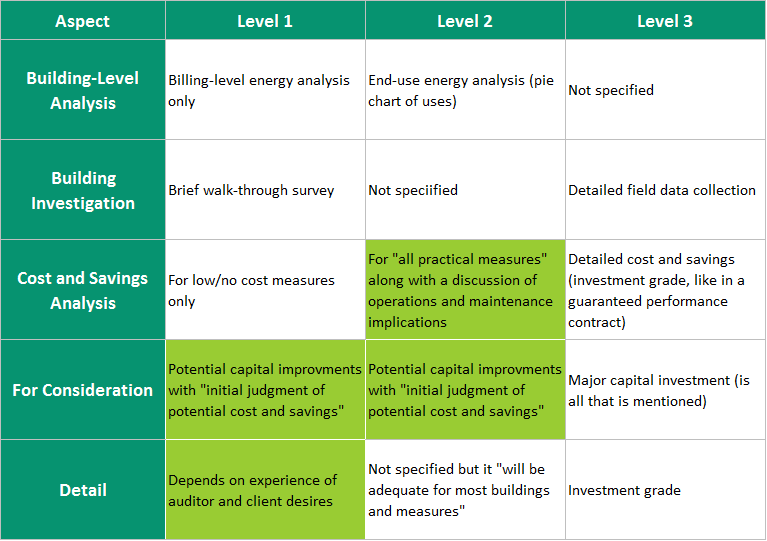

Summary of ASHRAE Audits Definitions
Just about every energy efficiency portfolio offers customers some sort of energy audit. They practically all feature home audits, audits with direct installation of measures, level II audits, feasibility studies and retro-commissioning studies. What are the differences between these audits?
As evaluators, implementers, regulators, utilities, and energy users (i.e. everyone reading this[1]), you need to know.
Like energy codes themselves, ASHRAE[2] is the source for defining various levels of audits. Audit levels 1, 2, and 3 simply define the rigor and depth of investigation and analysis provided by the audit.
I have never liked the ASHRAE definitions because they are too vague and nebulous. I was recently spurred to write about this subject as I was helping prepare some proposals for ASHRAE Level 1, 2, and 3 audits[3]. What are these definitions? I would probably be reprimanded for copyright if I put them in this blog, but they are long and treacherous. Pacific Northwest National Lab has crib-notes editions of them in this document, page 2.
I have reduced and summarized the formal ASHRAE definitions to the following table.
Every one of these has substantial flaws; some of which are highlighted.
What does “initial judgement of potential cost and savings” mean? I would get five different answers from five people. If I asked 100 people, I might get a couple pairs of meanings that are similar. Furthermore, there is no “judgment”. Once an engineer puts a number on something, it is assumed to be accurate to five significant figures. The scope and detail, i.e., “experience of auditor and specifications of the client”, can mean anything. If a client only wants a Level 1 audit, chances are high they are rookies in the business. They don’t know what scope they want.
What does “practical measures” mean, other than things that meet the owner’s financial criteria? Ever heard the phrase throwing good money after bad? Years ago, I had a 1990 Mazda that was about 12 years old. The brake lines were failing, mainly due to 4-5 months per year of massive doses of salt we get on the roads in Wisconsin. I spent a few hundred bucks to replace one line, and then a few months later, another line failed. You could do the same thing with a building – unwisely invest in a sinkhole while meeting some “criteria”. The right thing, the most appropriate thing, may be to face down the inevitable rather than throwing good money at bad stuff. Another problem with these is that a Level 3 emanates from a Level 2. Nobody wants shoot-from-the-hip results from a Level 2 mixed with detailed and accurate results from a Level 3. That’s like buying a Ford Fiesta and wanting the big Mustang engine to go with it.
To sum it up, each audit Level, in my 20 years’ experience, is associated with a level of investigation and rigor that the client wants, typically across the board; however, not always, as the Level 3 may focus only on certain plants or systems within the facility.
Instead of audit definitions that overlap and mush together like a Thanksgiving plate of potatoes, gravy, green bean casserole, and the beloved jello salad, draw clear lines along client desires as follows (table to the left). Examples of huge complex measures include:
- Heat recovery from an electric arc furnace in a steel mill. The exhaust is so hot the ductwork needs a water-cooled jacket to prevent melting. It’s in another dimension and requires a whole different level of thought.
- Doing what is necessary to shut down a district steam plant to save a lot of heat loss to surroundings for a few piddly loads in summertime. We have analyzed district heating systems on campuses that waste 30% of their thermal output year round.
In summary:
A Level 1 audit assesses the total opportunity and provides confidence where the savings will come from in the following categories: (1) low/no cost O&M or retro-commissioning, (2) standard retrofits like variable frequency drives and lighting replacements or (3) major upgrades that are needed for other reasons, like end of life.
A Level 2 audit roughly quantifies cost and savings for each measure for just about everything. Accuracy of any single measure is crude, but when many measures are added together, the net result should be quite accurate. However, a Level 3 analysis of some items is often warranted for the big stuff.
A Level 3 audit, also known as a feasibility study or retro-commissioning study, is warranted when the project is expected to show significant changes at the utility meter level, and/or when a lot of money needs to be spent on a long-term (more than 20 years) investment. [1] You can probably skip this one, Mom.
[2] American Society of Heating, Refrigerating and Air conditioning Engineers, HVAC Applications Handbook
[3] Formally, they use Roman numerals for these, but like the NFL, maybe, I despise the Romans – a jest, ok?
